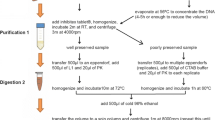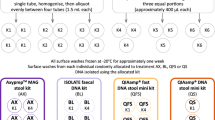Abstract
Feces represent an easily available, non-invasive source of DNA. Often DNA extraction from feces is compounded with contamination, dietary inhibitors and primarily low quantity and poor quality of host DNA. In an effort to improve host DNA recovery from fecal samples, a new DNA extraction methods was developed. The objectives of this project was to use non-invasive sampling techniques of feces from domestic horses, provide a viable protocol for an improved DNA extraction, and genotype using six equine microsatellite on feces aged for 6 days. The technique used a modified Qiagen® DNA Stool Mini Kit protocol (Q) with pressure cycling technology (PCT). The DNA yield using PCT extraction was five fold greater as compared to the Q. The PCT mediated Qiagen (Q + PCT) technique yielded complete (six loci) equine DNA profiles of 100 % samples ≤2 days old, 90 % at 4 days and 60 % at 6 days post defecation. The results indicated that the Q + PCT increased DNA yield, and thereby increased the likelihood of obtaining an equine DNA profile from aged fecal samples. Using ML-RELATE analyses, the profiles obtained from the six equine loci could also be used for kinship analysis. Samples aged up to Day 6 as well as pasture samples with unknown days since defecation were successful in individualization of the contributors and could also be used to analyze kinship. The Q + PCT method should prove to be an extremely useful and reliable method for conservation or forensic cases where fecal matter may be the only sample available for analyses.



Similar content being viewed by others
References
Anderson KL, Lebepe-Mazur S (2003) Comparison of rapid methods for the extraction of bacterial DNA from colonic and caecal lumen contents of the pig. J Appl Microbiol 94(6):988–993
Archie EA, Moss CJ, Alberts SC (2003) Characterization of tetranucleotide microsatellite loci in the African savannah elephant (Loxodonta africana africana). Mol Ecol Notes 3(2):244–246
Bellemain EVA, Swenson JE, Tallmon D, Brunberg S, Taberlet P (2005) Estimating population size of elusive animals with DNA from hunter-collected feces: four methods for brown bears. Conserv Biol 19(1):150–161
Bonin A, Bellemain E, Bronken Eidesen P, Pompanon F, Brochmann C, Taberlet P (2004) How to track and assess genotyping errors in population genetics studies. Mol Ecol 13(11):3261–3273
Bradley BJ, Vigilant L (2002) False alleles derived from microbial DNA pose a potential source of error in microsatellite genotyping of DNA from faeces. Mol Ecol Notes 2(4):602–605
Bradley DW, Hess RA, Tao F, Sciaba-Lentz L, Remaley AT, Laugharn JA, Manak M (2000) Pressure cycling technology: a novel approach to virus inactivation in plasma. Transfusion 40(2):193–200
Brettell TA, Butler JM, Almirall JR (2009) Forensic science. Anal Chem 81(12):4695–4711
Creel S, Spong G, Sands JL et al (2003) Population size estimation in Yellowstone wolves with error-prone noninvasive microsatellite genotypes. Mol Ecol 12(7):2003–2009
Deuter R, Pietsch S, Hertel S, Müller O (1995) A method for preparation of fecal DNA suitable for PCR. Nucleic Acids Res 23(18):3800–3801
Dimsoski P (2003) Development of a 17-plex microsatellite polymerase chain reaction kit for genotyping horses. Croatian Med J 44(3):332–335
Ellegren H, Johansson M, Sandberg K, Andersson L (1992) Cloning of highly polymorphic microsatellites in the horse. Anim Genet 23:133–142
Fernando P, Vidya TNC, Payne J et al (2003) DNA analysis indicates that Asian elephants are native to Borneo and are therefore a high priority for conservation. PLoS Biol 1(1):110–115
Flagstad Ø, Røed K, Stacy JE, Jakobsen KS (1999) Reliable noninvasive genotyping based on excremental PCR of nuclear DNA purified with a magnetic bead protocol. Mol Ecol 8(5):879–883
Garrett PE, Tao F, Lawrence N, Ji J, Schumacher RT, Manak MM (2002) Tired of the same old grind in the new genomics and proteomics era? Targets 1(5):156–162
Gross V, Carlson G, Kwan AT, Smejkal G, Freeman E, Ivanov AR, Lazarev A (2008a) Tissue fractionation by hydrostatic pressure cycling technology: the unified sample preparation technique for systems biology studies. J Biomol Tech 19(3):189
Gross V, Lazarev AV, Lawrence NP, Schumacher RT (2008b) Isolation of mitochondria from cell cultures by PCT for proteomic analysis. Biotechniques 45(1):99
Guérin G, Bertaud M, Amigues Y (1994) Characterization of seven new horse microsatellites: HMS1, HMS2, HMS3, HMS5, HMS6, HMS7 and HMS8. Anim Genet 25(S2):62
Harrington S, McCouch S, Tao F, Lawrence N, Schumacher RT (2004) Use of pressure cycling technology (pct) for the release of dna from plants. In: Annual plant, animal and microbes genomics conference. San Diego, CA
Johnson DJ, Martin LR, Roberts KA (2005) STR-typing of human DNA from human fecal matter using the QIAGEN QIAamp® stool mini kit. J Forensic Sci 50(4):802
Kalinowski ST, Wagner AP, Taper ML (2006) ML-Relate: a computer program for maximum likelihood estimation of relatedness and relationship. Mol Ecol Notes 6(2):576–579
Kohn MH (2010) Noninvasive genome sampling in chimpanzees. Mol Ecol 19(24):5328–5331
Kohn MH, Wayne RK (1997) Facts from feces revisited. Trends Ecol Evol 12(6):223–227
Kolodziej K, Theissinger K, Brün J, Schulz HK, Schulz R (2012) Determination of the minimum number of microsatellite markers for individual genotyping in wild boar (Sus scrofa) using a test with close relatives. Eur J Wildl Res 58(3):621–628
Linacre A, Gusmao L, Hecht W et al (2011) ISFG: recommendations regarding the use of non-human (animal) DNA in forensic genetic investigations. Forensic Sci Int Genet 5(5):501–505
Marklund S, Ellegren H, Eriksson S, Sandberg K, Andersson L (1994) Parentage testing and linkage analysis in the horse using a set of highly polymorphic microsatellites. Anim Genet 25(S2):19–23
McKelvey KS, Schwartz MK (2004) Genetic errors associated with population estimation using non-invasive molecular tagging: problems and new solutions. J Wildl Manag 68(3):439–448
Nechvatal JM, Ram JL, Basson MD, Namprachan P, Niec SR, Badsha KZ, Kato I et al (2008) Fecal collection, ambient preservation, and DNA extraction for PCR amplification of bacterial and human markers from human feces. J Microbiol Methods 72(2):124–132
Nori DV, McCord BR (2015) The application of alkaline lysis and pressure cycling technology in the differential extraction of DNA from sperm and epithelial cells recovered from cotton swabs. Anal Bioanal Chem 407(23):6975–6984
Norris DO, Bock JH (2000) Use of fecal material to associate a suspect with a crime scene: report of two cases. J Forensic Sci 45(1):184–187
Okubara PA, Schroeder KL, Li C, Schumacher RT, Lawrence NP (2007) Improved extraction of Rhizoctonia and Pythium DNA from wheat roots and soil samples using pressure cycling technology. Can J Plant Pathol 29(3):304–310
Piggott MP (2005) Effect of sample age and season of collection on the reliability of microsatellite genotyping of faecal DNA. Wildl Res 31(5):485–493
Piggott MP, Taylor AC (2003) Remote collection of animal DNA and its applications in conservation management and understanding the population biology of rare and cryptic species. Wildl Res 30(1):1–13
Pompanon F, Bonin A, Bellemain E, Taberlet P (2005) Genotyping errors: causes, consequences and solutions. Nat Rev Genet 6(11):846–847
Renan S, Speyer E, Shahar N, Gueta T, Templeton AR, Bar-David S (2012) A factoral design experiment as a pilot study for noninvasive genetic sampling. Mol Ecol Res 12(6):1040–1047
Santini A, Lucchini V, Fabbri E, Randi E (2007) Ageing and environmental factors affect PCR success in wolf (Canis lupus) excremental DNA samples. Mol Ecol Notes 7(6):955–961
Smejkal GB, Robinson MH, Lawrence NP, Tao F, Saravis CA, Schumacher RT (2006) Increased protein yields from Escherichia coli using pressure-cycling technology. J Biomol Tech 17(2):173
Tao F, Lawrence NP, Miller W et al (2003) Biological sample preparation system using pressure cycling technology (PCT). In: Winter R (ed) Advances in high pressure bioscience and biotechnology II. Springer, Berlin, pp 413–417
Van de Goor LHP, Panneman H, Van Haeringen WA (2009) A proposal for standardization in forensic equine DNA typing: allele nomenclature of 17 equine-specific STR loci. Anim Genet 41:122–127
van Haeringen H, Bowling AT, Stott ML, Lenstra JA, Zwaagstra KA (1994) A highly polymorphic horse microsatellite locus: VHL20. Anim Genet 25(3):207
Waits LP, Paetkau D (2005) Noninvasive genetic sampling tools for wildlife biologists: a review of applications and recommendations for accurate data collection. J Wildl Manag 69(4):1419–1433
Wehausen JD, Ramey RR, Epps CW (2004) Experiments in DNA extraction and PCR amplification from bighorn sheep feces: the importance of DNA extraction method. J Hered 95(6):503–509
Yu Z, Morrison M (2004) Improved extraction of PCR-quality community DNA from digesta and fecal samples. Biotechniques 36(5):808–813
Yuan MQ, Tu Z, Li CX (2011) A rapid and effective bone DNA extraction method using pressure cycling technology. Forensic Sci Technol 4:012
Acknowledgments
The authors thank the Forensic DNA Profiling Facility, International Forensic Research Institute, Florida International University for their instrumental support and Beatrice Kallifatidis, MSFS, for her support and guidance.
Author information
Authors and Affiliations
Corresponding author
Ethics declarations
Conflict of interest
The authors have declared no conflict of interest.
Additional information
An erratum to this article is available at http://dx.doi.org/10.1007/s12686-016-0579-y.
Rights and permissions
About this article
Cite this article
Deshpande, K., Villarreal, M. & Mills, D.K. Improved DNA profiles from aged horse feces using pressure cycling technology. Conservation Genet Resour 8, 487–495 (2016). https://doi.org/10.1007/s12686-016-0572-5
Received:
Accepted:
Published:
Issue Date:
DOI: https://doi.org/10.1007/s12686-016-0572-5




